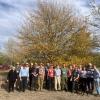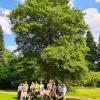Editor's Picks
Plant Focus
Jeannine Cavender-Bares
Published May 2016 in International Oaks No. 27: 37–48.
Abstract
The American oak clade provides an important system in which to test theory about the role of diversification and ecological filtering processes in community assembly at continental scale. Together with a number of long-standing collaborators1, we investigated the nature of functional trait evolution, environmental filtering and community assembly for the American oaks. We found evidence for inertia in the evolution of freezing tolerance, despite strong associations between freezing tolerances and climatic distribution, indicating that species are sorting across climatic gradients with a strong influence of ancestry, only slowly adapting to novel conditions. In contrast, plant water use and hydraulic traits are highly labile across the phylogeny, consistent with adaptive radiation into diverse hydrologic niches. Phylogenetic patterns of community composition are consistent with conserved climatic niches with in-situ divergence into contrasting local habitats.
_________________________
1 B. Fallon, A. González-Rodríguez, A.L. Hipp, F. Hoerner, M. Kaproth, P.S. Manos, J. Meireles, J. McVay, and I. Pearse
Keywords
parallel adaptive radiation, community assembly, biogeography
References
Abrams, M.D. 1990. Adaptations and responses to drought in Quercus species of North America. Tree Physiology 7: 227-238.
Abrams, M.D. 1992. Fire and the development of oak forests. BioScience 42: 346-353.
Abrams, M.D. 1996. Distribution, historical development and ecophysiological attributes of oak species in the eastern United States. Annales Des Sciences Forestieres 53: 487-512.
Arkema, K.K., G. Guannel, G. Verutes, S. A. Wood, A. Guerry, M. Ruckelshaus, P. Kareiva, M. Lacayo, and J.M. Silver. 2013. Coastal habitats shield people and property from sea-level rise and storms. Nature Clim. Change 3: 913-918.
Bahari, Z.A., S G. Pallardy, and W.C. Parker. 1985. Photosynthesis, water relations, and drought adaptation in six woody species of oak-hickory forests in central Missouri. Forest Science 31: 557-569.
Callaway, R.M. and F.W. Davis. 1998. Recruitment of Quercus agrifolia in central California: the importance of shrub-dominated patches. Journal of Vegetation Science 9: 647-656.
Cavender-Bares, J., D.D. Ackerly, D.A. Baum, and F.A. Bazzaz. 2004a. Phylogenetic overdispersion in Floridian oak communities. American Naturalist 163: 823-843.
Cavender-Bares, J., K. Kitajima, and F. Bazzaz. 2004b. Multiple trait associations in relation to habitat differentiation among 17 Floridian oak species. Ecological Monographs 74: 635-662.
Cavender-Bares, J. and P.B. Reich. 2012. Shocks to the system: Community assembly of the oak savanna in a 40‐year fire frequency experiment. Ecology 93: S52-S69.
Chuine, I. and E.G. Beaubien. 2002. Phenology is a major determinant of tree species range (vol 4, pg 500, 2001). Ecology Letters 5: 316-316.
Craft, K. J., M.V. Ashley, and W.D. Koenig. 2002. Limited hybridization between Quercus lobata and Quercus douglasii (Fagaceae) in a mixed stand in central coastal California. American Journal of Botany 89: 1792-1798.
Crepet, W.L. 1989. History and implications of the early North American fossil record of Fagaceae. Pages 45-66 in P. R. Crane and S. Blackmore, editors. Evolution, Systematics, and Fossil History of the Hamamelidae. Oxford: Clarendon Press.
Crepet, W.L. and K.C. Nixon. 1989. Earliest megafossil evidence of Fagaceae: Phylogenetic and biogeographic implications. American Journal of Botany 76: 842-855.
Curtu, A.L., O. Gailing, and R. Finkeldey. 2007. Evidence for hybridization and introgression within a species-rich oak (Quercus spp.) community. BMC Evolutionary Biology 7: 218.
Daghlian, C.P. and W.L. Crepet. 1983. Oak catkins, leaves and fruits from the Oligocene Catahoula formation and their evolutionary significance. American Journal of Botany 70: 639-649.
Eaton, D., A. Gonzalez-Rodriguez, A. Hipp, and J. Cavender-Bares. 2015. Historical introgression among the American live oaks and the comparative nature of tests for introgression. Evolution:DOI: 10.1111/evo.12758.
Gailing, O., & Curtu, A.L. (2014). Interspecific gene flow and maintenance of species integrity in oaks. Ann. For. Res., 57, 5-18
González-Rodríguez, A., J.F. Bain, J.L. Golden, and K. Oyama. 2004. Chloroplast DNA variation in the Quercus affinis-Q. laurina complex in Mexico: geographical structure and associations with nuclear and morphological variation. Molecular Ecology 13: 3467-3476.
Graham, A. 1999a. Late Cretaceous and Cenozoic history of North American vegetation north of Mexico. New York: Oxford University Press.
Graham, A. 1999b. The tertiary history of the northern temperate element in the northern Latin American biota. American Journal of Botany 86: 32-38.
Hayward, A. and G.N. Stone. 2005. Oak gall wasp communities: Evolution and ecology. Basic and Applied Ecology 6: 435-443.
Hipp, A. L., D.A. Eaton, J. Cavender-Bares, E. Fitzek, R. Nipper, and P.S. Manos. 2014. A framework phylogeny of the American oak clade based on sequenced RAD data. PloS one 9: e93975.
Jackson, J. F., D. C. Adams, and U. B. Jackson. 1999. Allometry of constitutive defense: a model and a comparative test with tree bark and fire regime. American Naturalist 153: 614-632.
Kappelle, M. 2006. Ecology and conservation of neotropical montane oak forests. New York: Spinger-Verlag.
Kissing, L. and J. Powers. 2010. Coarse woody debris stocks as a function of forest type and stand age in Costa Rican tropical dry forest: long-lasting legacies of previous land use. Journal of Tropical Ecology 26: 467-471.
Klemens, J.A., N.J. Deacon, and J. Cavender-Bares. 2011. Pasture recolonization by a tropical oak and the regeneration ecology of seasonally dry tropical forests. Pages 221-237 Seasonally Dry Tropical Forests. Island Press/Center for Resource Economics.
Koehler, K., A. Center, and J. Cavender‐Bares. 2012. Evidence for a freezing tolerance–growth rate trade‐off in the live oaks (Quercus series Virentes) across the tropical–temperate divide. New Phytologist 193: 730-744.
Koenig, W.D. 1999. Oaks, acorns, and the geographical ecology of acorn woodpeckers. Journal of Biogeography 26: 159-165.
Kossoy, A., G. Peszko, K. Oppermann, N. Prytz, N.M. Klein, K. Blok, L. Lam, L. Wong, and B. Borkent. 2015. State and Trends of Carbon Pricing. Washington, D.C.: World Bank.
Mann, C.C. 2005. 1491: New Revelations of the Americas Before Columbus. New York: Knopf.
Manos, P.S. and A.M. Stanford. 2001. The historical biogeography of Fagaceae: Tracking the tertiary history of temperate and subtropical forests of the Northern Hemisphere. International Journal of Plant Sciences 162: S77-S93.
Martin, T.G. 1997. Building Constitution, By Commander Tyrone G. Martin, U. S. Navy (Retired). https://ussconstitutionmuseum.org/constitution-resources/the-captain-speaks/building-constitution/. A TIMONIER Publication, TGM, USS Constitution Museum,| Charlestown Navy Yard, Charlestown, MA.
Miles, P.D. and B.W. Smith. 2009. Specific gravity and other properties of wood and bark for 156 tree species found in North America. USDA Forest Service: Northern Research Station Research Note NRS-38.
Mohler, C. L. 1990. Co-occurrence of oak subgenera: implications for niche differentiation. Bull. Torrey Bot. Club 117: 247-255.
Monk, C.D. 1968. Successional and environmental relationships of the forest vegetation of north central Florida. American Midland Naturalist 79: 441-457.
Morin, X., D. Viner, and I. Chuine. 2008. Tree species range shifts at a continental scale: new predictive insights from a process-based model. Journal of Ecology 96: 784-794.
Morueta-Holme, N., B.J. Enquist, B.J. McGill, B. Boyle, P.M. Jørgensen, J.E. Ott, R.K. Peet, I. Šímová, L.L. Sloat, B. Thiers, C. Violle, S.K. Wiser, S. Dolins, J.C. Donoghue, N.J.B. Kraft, J. Regetz, M. Schildhauer, N. Spencer, and J.-C. Svenning. 2013. Habitat area and climate stability determine geographical variation in plant species range sizes. Ecology Letters, 16, 1446-1454
Myers, R. L. 1990. Scrub and High Pine. Pages 150-193 in R. L. Myers and J. J. Ewel, editors. Ecosystems of Florida. Orlando: University of Central Florida Press.
Nixon, K.C., editor. 1993. The genus Quercus in Mexico. Oxford: Oxford University Press.
Nixon, K.C. 1997. Quercus Linnaeus. Pages 431-506 in F. o. N. A. E. Committee, editor. Flora of North America North of Mexico. New York: Oxford University Press.
Nowak, D.J., S. Hirabayashi, A. Bodine, and R. Hoehn. 2013. Modeled PM2.5 removal by trees in ten U.S. cities and associated health effects. Environmental Pollution 178: 395-402.
Oh, S H. and P.S. Manos. 2008. Molecular phylogenetics and cupule evolution in Fagaceae as inferred from nuclear CRABS CLAW sequences. Taxon 57: 434-451.
Packard, S. and C. Mutel. 1997. The tallgrass restoration handbook: for prairies, savannas and woodlands. Covelo: Island Press, Washington, D.C.
Pearse, I.S. and A.L. Hipp. 2009. Phylogenetic and trait similarity to a native species predict herbivory on non-native oaks. PNAS 106: 18097-18102.
Peterson, D.W. and P.B. Reich. 2008. Fire frequency and tree canopy structure influence plant species diversity in a forestgrassland ecotone. Plant Ecology 194: 5-16.
Petit, R.J., J. Carlson, A.L. Curtu, M.-L. Loustau, C. Plomion, A. Gonzalez-Rodrıguez, V. Sork, and A. Ducousso. 2013. Fagaceae trees as models to integrate ecology, evolution and genomics: IUFRO Conference, Genetics of Fagaceae and Nothofagaceae, in Bordeaux, France, October 2012. New Phytologist 197: 369–371.
Petit, R.J., A. Kremer, and D.B. Wagner. 1993. Geographic structure of chloroplast DNA polymorphisms in European oaks. Theor. Appl. Genet. 87: 122-128.
Ramírez-Valiente, J.A., K. Koehler, and J. Cavender-Bares. 2015. Climatic origins predict variation in photoprotective leaf pigments in response to drought and low temperatures in live oaks (Quercus series Virentes). Tree Physiology: http://dx.doi.org/10.1093/treephys/tpv1003.
Rodríguez-Correa, H., K. Oyama, I. MacGregor-Fors, and A. González-Rodríguez. 2015. How are oaks distributed in the Neotropics? A perspective from species turnover, areas of endemism, and climatic niches. International Journal of Plant Sciences.
Sork, V.L., F. W. Davis, P.E. Smouse, V.J. Apsit, R.J. Dyer, J.F. Fernandez, and B. Kuhn. 2002. Pollen movement in declining populations of California Valley oak, Quercus lobata: where have all the fathers gone? Molecular Ecology 11: 1657-1668.
Spector, T. and F. E. Putz. 2006. Crown retreat of open-grown Southern live oaks (Quercus virginiana) due to canopy encroachment in Florida, USA. Forest Ecology and Management 228: 168–176.
Steele, M.A., P.D. Smallwood, A. Spunar, and E. Nelsen. 2001. The proximate basis of the oak dispersal syndrome: Detection of seed dormancy by rodents. American Zoologist 41: 852-864.
Tucker, J. M. 1974. Patterns of parallel evolution of leaf form in New World oaks. Taxon 23: 129-154.
Valencia, S. 2004. Diversidad del genero Quercus (Fagaceae) en Mexico. Bol. Soc. Bot. Mex 75: 33-53.
Valladares, F., L. Balaguer, E. Martinez-Ferri, E. Perez-Corona, and E. Manrique. 2002. Plasticity, instability and canalization: is the phenotypic variation in seedlings of sclerophyll oaks consistent with the environmental unpredictability of Mediterranean ecosystems? New Phytologist 156: 457-467.
Whittaker, R.H. and W.A. Niering. 1975. Vegetation of the Santa Catalina Mountains, Arizona. V. Biomass, Production, and Diversity along the Elevation Gradient. Ecology 56: 771-790.
Wiens, J.J. and M.J. Donoghue. 2004. Historical biogeography, ecology and species richness. Trends in Ecology and Evolution 19: 639-644.
Zachos, J., M. Pagani, L. Sloan, E. Thomas, and K. Billups. 2001. Trends, Rhythms, and aberrations in global climate 65 Ma to present. Science 292: 686-693.















